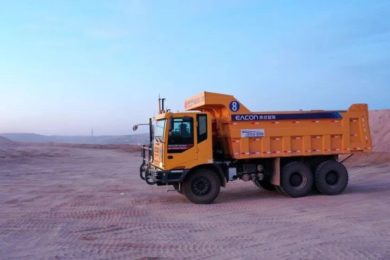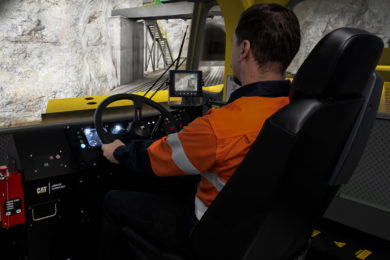China represents one of the largest markets in the world for autonomous haulage – involving automation of both rigid mining trucks as well as so-called wide body trucks. TAGE Idriver and WAYTOUS are now quite well known in this market as key tech providers, but there are also other up and coming players with new technologies. One of these is EACON, official name Beijing Yikong Zhijia Technology, which has only been active for less than four years but is already making an impact. IM posed some questions to the company to get some insight into its particular approach to AHS.
Q When was EACON established as a company and how did you get into the autonomous mining vehicle market?
We were officially registered in May 2018. Our CEO, Wason Lan, is a successful serial entrepreneur. He has founded several companies, including the Egame company, which was acquired by Baotong Technology for a consideration of 1 billion yuan in cash and 1 billion yuan in stock. In 2016, Wason began to look for a new start-up idea, and finally decided to work on driverless solution for mining trucks. This decision he took mainly due to the following reasons. First, unmanned driving can effectively eliminate the risks of safety in mining, which is of great social value; he was also aware that Komatsu and Caterpillar already had successful autonomous haulage projects running in Australia, confirming that the feasibility of the technology is very high. Finally, the main business of Baotong Technology is mining conveyor equipment and through Baotong, Wason got familiar with the ecosystem of mining, as well as the market pain points and needs. In 2017, Wason began to look for co-founders. After talking with more than ten teams, he got to know Zhang Lei’s team. Zhang Lei now EACON Chairman used to be the head of the self driving R&D project at Yutong Bus, with more than 10 years of experience in unmanned driving R&D and mine equipment automation. Wason and Lei both recognised the direction of unmanned driving for mining trucks, and finally confirmed the cooperation and jointly founded EACON in 2018.
Q How would you differentiate your approach and technology to that of other autonomy tech players in China such as TAGE Idriver and WAYTOUS?
The founders of TAGE Idriver and WAYTOUS are Professors from universities. Our Founder Wason is a serial entrepreneur, who we believe has more advantages in the management and operation of the company, and has also figured out the business model at the starting point of EACON. Zhang Lei and our R&D team work in remote mines for most of the year, so they have a deep understanding of the technical requirements and mining scenarios. Our team does not only have autonomous vehicle professionals from leading enterprises, but also has senior experts with years of experience in the mining industry. In addition, we built a vehicle engineering team in October 2021 to deepen our R&D in drive-by-wire control chassis plus the VCU of BEV/FCEV etc. And they have a deeper understanding of wide body trucks, especially BEV/FCEV variants. We have already realised autonomous haulage with four fleets in one mine, including four excavators and 24 driverless trucks. And we believe that we are one of the only solution providers in China that can carry out normal autonomous haulage operation without safety drivers. Moreover, our driverless trip mileage and hauled overburden tonnages are also ahead of other companies. Our system is a four-in-one mine unmanned driving technology that integrates the dispatching command platform and supporting dispatching centre, single vehicle unmanned driving system, network communication system and collaborative operation system.
Q Where is your main equpiment focus and who has invested in EACON to date?
We are currently focusing on wide body trucks. China’s supply chain and OEMs have more technical advantages in this area and this type of truck is easier to electrify. TAGE Idriver and WAYTOUS mainly focus on large rigid mining trucks and partnered up with Chinese rigid truck OEMs. They also have self-driving wide body trucks, but we feel our technology in this area is more mature. We have obtained investment from Zijin Mining, and we are one of the only players in this field that has received investment directly from mining enterprises. In addition, other investors include Eight Roads, a global venture capital firm backed by Fidelity plus Neo Capital, a US fund. Finally, we own an earthworks contracting company which operates a non-autonomous driving haulage business which helps us cultivate on-site operators for self-driving and understand the needs of mining haulage.
Q Are you mainly working with the mines directly or with the OEMs of the smaller trucks directly like XCMG/Yutong/Liugong/Tonly/LGMG/Sany etc? Are there any of the OEMs that you have been working with more closely?
Yes, we cooperate directly with OEMs, and have a deep relationship with Tonly, LGMG and Yutong. We forward our own designs and suggestions on the drive-by-wire systems, automated driving system, and battery, motor and electric control system to them. They carry out factory design, verification, installation and mass-production according to our requirements, so as to meet the stability and consistency requirements required by unmanned driving.
Q Can you give any specific examples of these cooperation relationships with the OEMs?
On November 15, a signing ceremony marking a strategic cooperation between Yutong Mining Equipment and EACON and our first batch of battery trucks was held in Zhengzhou. The signing represented an official start of the strategic cooperation between the two companies, and it will accelerate the intelligent and low-carbon development of China’s mines. Zhang Lei spoke highly of the strength of Yutong mining trucks: “Yutong Mining Equipment is one of the earliest OEMs focused on the R&D and sales of wide-body mining trucks. Its products are superior in technology, material selection, workmanship, quality control and service, which can bring great value to partners. Powered by Yutong’s marketing of the mining truck and its advantages of three e-systems, EACON will leverage its full stack of driver-less technical solutions and operation services to provide users with first-class driver-less mine products and services.”
Q How does the structure of the wide body trucks differ to rigid trucks and how does this influence the cost?
The notable parts of a rigid mining truck include welded frame, hydro pneumatic spring and usually today an electric-drive wheel. The traditional wide body truck is based on the road heavy-duty truck. The frame, cargo box, axle, tyres and other parts have been modified and enhanced according to mining working conditions. The main components of a wide body truck are mainly a riveted frame, leaf spring and gearbox ie mechanical transmission. However, with the emergence of larger tonnage wide body vehicles, the boundary between these two types of trucks will gradually blur. The 90 t class wide body truck on which we have cooperated with an OEM has also adopted a welded frame and hydro pneumatic spring. The mass utilisation coefficient (payload/machine weight) of small rigid trucks is very low, while that of wide body truck is higher. The price of a small rigid truck is also much higher than that of wide body vehicles. For example, the price of a small rigid truck is about 11-20 times the payload, (a 70 t payload rigid truck will cost around US$783,000-1,468,000) while that of a wide body truck is only 1.3-2 times (a 70 t payload wide body truck will cost around US$98,000-147,000). Thanks to these advantages, wide body trucks are much more widely used in China.
Q You mentioned that one of the reasons you are working with the smaller trucks is that it is easier to electrify those trucks – does that mean that automating fleets of electric trucks is your main focus – does that include automating the vehicle journeys to the charger or battery swap areas?
Because our previous projects started some years back, they are all conventional diesel trucks. With the maturity of electric mining trucks in recent years and the founding of our EV R&D team, we have established in-depth R&D cooperation with OEMs on green energy mining trucks regarding all battery and hybrid power types. So our next driverless fleets will focus on the green energy mining trucks, but at the same time, our fuel truck solutions will also keep optimising in parallel with them, and our autonomous haulage solution will move from V2.0 to V3.0. In terms of green energy self-driving, our current trucks in development are rechargeable in type. Automated driving will cover the journey to the charger, but the charging operation will still be manual. In the future, we will also adopt trucks with integrated charging and battery swap functions.
Q Can you give any examples of autonomous fleets you have running in China?
We have deployed in two large open-pit coal mines, both with prodution capacities of over 35 Mt/y. One of these is Tianchi Energy South open pit coal mine where we are providing driverless overburden stripping and haulage services. The project started in November 2020, and by June 2022, we began 24/7 continuous operation of four fleets, including four excavators and 24 unmanned diesel trucks. By the end of October 2022, the accumulated volume of overburden hauled by the driverless trucks was 4.212 million cubic metres while they had travelled 767,000 kilometres and made 198,000 trips. The other mine is Zhundong open pit coal mine. Both mines are located in the Xinjiang region.










